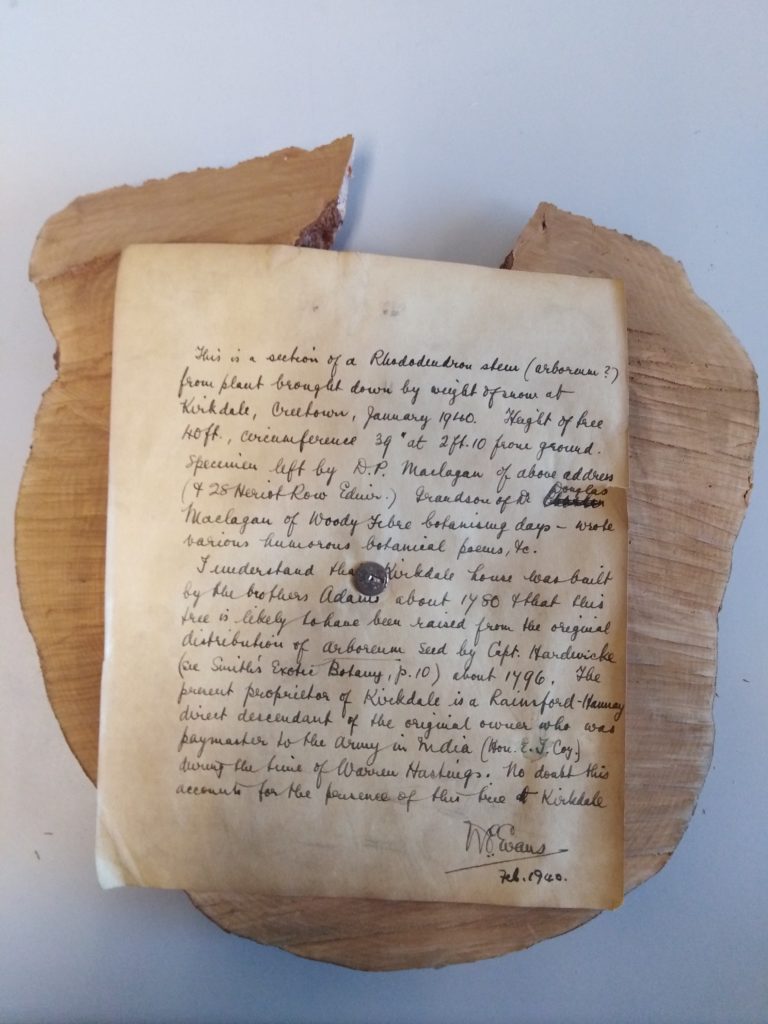This unassuming section of trunk was sitting on a desk in the herbarium office after being “discovered” in the back of a carpological cupboard. It arrived in our collection in February 1940 and is possibly from a plant of Rhododendron arboreum grown from the very first introduction of this species in 1797.
The history of this species is well known. Captain Thomas Hardwicke, who on a journey to Sirinagur [Srinagar] in Uttarakhand, not the place of the same name in Kashmir, describes a large crimson flowered unknown tree that “approaches nearest to Rhododendron, but will probably not be admissible here; and, perhaps, will form a new genus. The natives called it Boorans, the wood is used for making the stocks of matchlocks.”
The species was formally described as Rhododendron arboreum by James Edward Smith of the Linnean Society of London, in his Exotic Botany in 1805. Smith made use of Hardwicke’s notes and also an illustration made by an Indian born, East India Company artist travelling with Hardwicke. The original illustration and others this Indian artist and others comissioned by Harwicke are now in the keeping of the Natural History Museum, London.
Smith finished the article stating that it was hoped that the distributed seed would “…enrich our collections with this noble tree”. Hardwicke had arranged for seed to be collected and distributed back to Britain.

The pinned note is by William Edgar Evans who assistant in charge of the Herbarium at RBGE from 1919 to 1944. Its is transcribed below.
The is a section of Rhododendron stem (arboreum?) from plant brought down by weight of snow at Kirkdale, Creetown, January 1940. Height of tree 40ft, circumference 39” at 2ft 10 from ground.
Specimen left by D.P.Maclagan of above address (& 28 Heriot Row Edin.). Grandson of Dr Douglas Maclagan of Woody Fibre botanising days – wrote various humorous botanical poems, &c.
I understand that Kirkdale house was built by the brothers Adams about 1780 & that this tree is likely to have been raised from the original distribution of arboreum seed by Capt. Hardwicke (see Smith’s Exotic Botany, p10) about 1796. The present proprietors of Kirkdale is a Rainsford-Hannay direct descendant of the original owner who was paymaster to the army in India (Hon E. I. Coy.) during the time of Warren Hastings. No doubt, this accounts for the presence of this tree at Kirkdale.
W.E.Evans Feb 1940
Although collection, introduction and even the earliest cultivation of this species is not directly linked to RBGE, there are a number of connections of note in the story.
Kirkdale house was designed by Robert Adam who designed the Linnaeus Monument here in the garden and it was his brother John who was the architect who designed The Botanic’s Cottage.
Mr D.P. Maclagan who handed in the section of trunk was the grandson of Andrew Douglas Maclagan, the noted toxicologist and contemporary of Regius Professor of Botany and Keeper of the Royal Botanic Garden Edinburgh, John Hutton Balfour, affectionately known as Woody Fibre. You can read one of Douglas Maclagan’s ‘humorous poems’ “The battle of Glen Tilt” which is about J.H. Balfour’s infamous run in with Duke of Atholl‘s men here.
I should also note that it is generally either Nathaniel Wallich or Francis Buchanan-Hamilton (another person deeply linked with our history) that are attributed with the first successful introduction of Rhododendron arboreum around the 1820s through the Calcutta Botanic Garden. So both these individuals are likely sources of this plant, but it is tempting to think that it might just be a wee bit older than that.
Its amazing where a bit of wood in a cupboard can take you.

1 Comment
1 Pingback